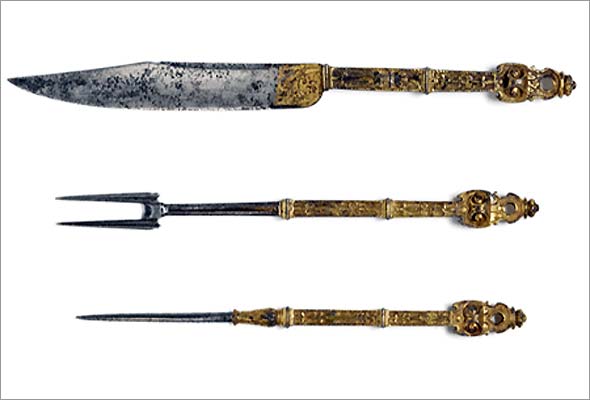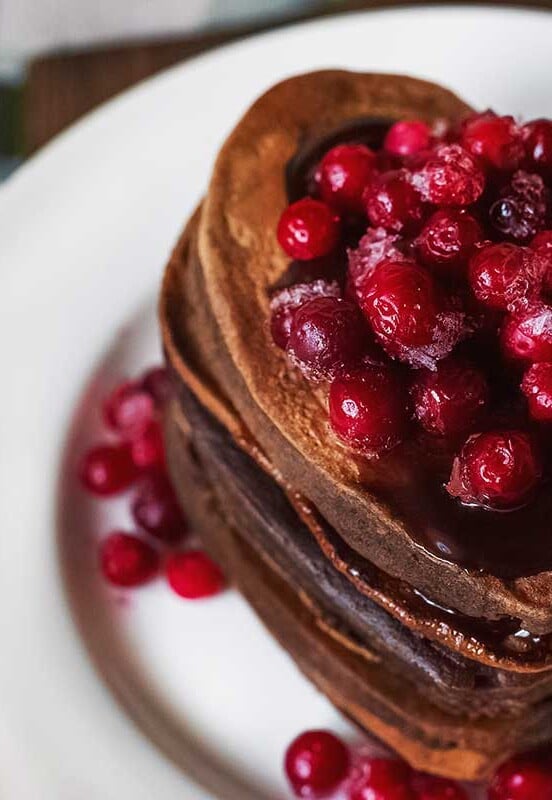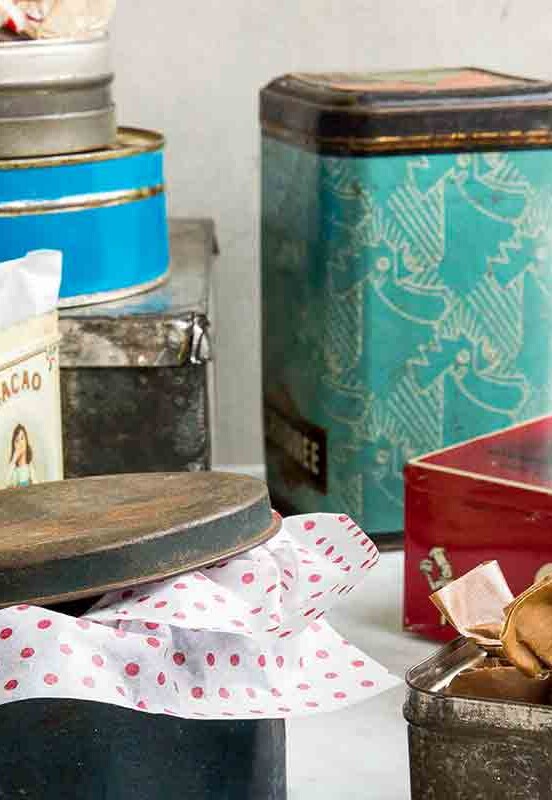
When we pick up a dinner fork we rarely think about how or why it came to be. Using it is as natural as using our own hands. But the fork is a relative newcomer to the table, appearing many centuries, even millennia, after the knife and spoon. The fork’s short and rocky history is the story of the evolution of etiquette and table manners. It’s also the story of how a doomed Byzantine princess, a French Cardinal disgusted by his dinner guests, and an intrepid English traveler forever changed the way western society eats.
Forks were in use in ancient Egypt, as well as Greece and Rome. However, they weren’t used for eating, but were, rather, lengthy cooking tools used for carving or lifting meats from a cauldron or the fire. Most diners ate with their fingers and a knife, which they brought with them to the table. Forks for dining only started to appear in the noble courts of the Middle East and the Byzantine Empire in about the 7th century and became common among wealthy families of the regions by the 10th century. Elsewhere, including Europe, where the favored implements were the knife and the hand, the fork was conspicuously absent.
Imagine the astonishment then when in 1004 Maria Argyropoulina, Greek niece of Byzantine Emperor Basil II, showed up in Venice for her marriage to Giovanni, son of the Pietro Orseolo II, the Doge of Venice, with a case of golden forks—and then proceeded to use them at the wedding feast. They weren’t exactly a hit. She was roundly condemned by the local clergy for her decadence, with one going so far as to say, “God in his wisdom has provided man with natural forks—his fingers. Therefore it is an insult to him to substitute artificial metal forks for them when eating.”
When Argyropoulina died of the plague two years later, Saint Peter Damian, with ill-concealed satisfaction, suggested that it was God’s punishment for her lavish ways. “Nor did she deign to touch her food with her fingers, but would command her eunuchs to cut it up into small pieces, which she would impale on a certain golden instrument with two prongs and thus carry to her mouth. . . . this woman’s vanity was hateful to Almighty God; and so, unmistakably, did He take his revenge. For He raised over her the sword of His divine justice, so that her whole body did putrefy and all her limbs began to wither.”
Doomed by God for using a fork. Life was harsh in the 11th century.
After this inauspicious debut, forks were understandably slow to catch on. But Maria’s Byzantine manners did make inroads. By the late Middle Ages the spread of forks can be tracked by their appearance in city inventories and as items of value bequeathed in wills. These suckett forks were used primarily for eating candied fruits in syrup or foods likely to stain the fingers. According to some sources, eating sweets with a fork was a practice common among courtesans, causing the Church to ban forks as immoral.
By the 1400s dining forks began to appear in Italian cookbooks, and it was another noble marriage that spread the influence. Italian forks became popular in the French court when Catherine de Medici arrived from Italy to marry the future Henry II, bringing several dozen intricate silver forks with her. Henry’s courtiers were ridiculed for the amount of food they spilled trying to eat with the unfamiliar forks. Despite the laughter, the use of forks spread to wealthy French families eager to adopt the new Italian vogue.
While forks were becoming more common on the continent, it took a brave English traveler to bring them across the channel. Thomas Coryate traveled extensively throughout France, Italy, Switzerland and Germany in 1608 and published an account of his journey after his return to England. Crudities Hastily Gobbled Up in Five Months or Coryates Crudites contained this observation on eating in Italy:
“I observed a custome in all those Italian Cities and Townes through which I passed, that is not used in any other country that I saw in my travels . . . The Italian, and also most strangers that are commorant in Italy, doe alwaies, at their meales use a little forke when they cut the meate; for while with their knife, which they hold in one hand, they cut the meate out of the dish, they fasten their forke which they hold in their other hande, upon the same dish, so that whatsoever he be that sitteth in the company of any others at meate, should unadvisedly touch the dish of meate with his fingers, from which all at the table doe cut he will give occasion of offence unto the company as having transgressed the lawes of good manners . . . The reason of this their curiosity, is because the Italian cannot by any means endure to have his dish touched with fingers, seeing all men’s fingers are not alike cleane. Hereupon I myselfe thought good to imitate the Italian fashion by this forked cutting of meate, not only while I was in Italy, but also in Germany, and oftentimes in England, since I came home.”
For his troubles his friends called him Furcifer. Our word fork comes from the Latin furca, so furcifer literally means “fork-bearer” but was also an acerbic pun; in the slang of the day, furcifer was also a man doomed to hang.
As the fork grew in popularity it also changed form. The straight, two-pronged fork was fine for spearing foods but not well adapted to scooping. A third, and sometimes fourth, tine made food less likely to slip through, and adding a slight curve to the tines made it an even more efficient scoop. The new shape and function of the fork led to a remarkable change in the design of table knives, which led to a dining divide between Europe and American that continues today.
The rift started, by some accounts, with Cardinal Richelieu, chief minister to France’s King Louis XIII, who was so disgusted by a frequent dinner guest’s habit of picking his teeth with his knife that l’Éminence Rouge, as Richelieu was known, had the tips of the offender’s knives ground down to prevent it happening. Always desperate to follow fashion, others in the court soon did the same. Whether the story is true or not, once forks began to gain popular acceptance there was no longer any need for a pointed tip at the end of a dinner knife to hold and spear the food. In 1669, King Louis XIV of France decreed all pointed knives on the street or the dinner table illegal. Not only were new knives to be made with rounded tips, all existing table knives were to be rounded off to reduce the potential for violence. The new style of knife rapidly spread to other European countries, including England.
By the beginning of the 18th century, knives imported to the American colonies had the new blunt tips. Because Americans had very few forks and no longer had sharp-tipped knives to spear food, they had to use spoons in instead. They’d use the spoon in the left hand to steady the food as they cut it with the knife in the right. They’d then switch the spoon to the opposite hand in order to scoop it up to eat. Our distinctly American style of eating continued even after forks became commonplace in the United States. Emily Post calls the practice “zigzagging” in her 1920s etiquette books. I like think of it as the American Shuffle.
Well into the 1800s forks were still considered an affection by some, and the source of confusion to others. One diner in Maine complained that, “Eating peas with a fork is as bad as trying to eat soup with a knitting needle.” In his 1824 memoir, wealthy English silversmith Joseph Brasbridge had to admit to his host at a dinner, “I know how to sell these articles, but not how to use them.” And as late as 1842 Charles Dickens noted that fellow passengers on a Pennsylvania river boat, “thrust their broad bladed knives and two-pronged forks further down their throats than I ever saw the same weapons go before, except in the hands of a skilled juggler.”
By the time of the first World’s Fair in 1851, the fork reigned supreme and required a new set of rules to help the confused or socially self conscious. Like it or not, the fork had arrived and modern dining began. As one 1887 book of manners put it,
“The fork has now become the favorite and fashionable utensil for conveying food to the mouth. First it crowded out the knife, and now in its pride it has invaded the domain of the once powerful spoon. The spoon is now pretty well subdued also, and the fork, insolent and triumphant, has become a sumptuary tyrant. The true devotee of fashion does not dare to use a spoon except to stir his tea or to eat his soup with, and meekly eats his ice-cream with a fork and pretends to like it.”
As Jacob Bronowski points out in The Origins of Knowledge and Imgination, “A knife and a fork are not merely utensils for eating. They are utensils for eating in a society in which eating is done with a knife and fork. And that is a special kind of society.” Other societies have evolved chopsticks or more ritualized use of the fingers for eating, but the fork is a uniquely western approach to dining. However, following the delirious profusion of pickle forks, fish forks, pastry forks, and oyster forks of the Victorian table, the pendulum has swung the other way. The rise of casual dining, convenience foods and drive-throughs means that for the first time since the 1500s we regularly eat complete meals with our hands. Forks and knives may again become the source of confusion and social unease. If history is any guide, it’s about time for another Furcifer, an intrepid and well-traveled diner, ridiculed at first, who will change the way we eat forever.












Please solve my problem! I have a carving fork with a lever. I cannot imagine what this device is for and how to use it. Most responses I’ve found are not logical.
Jose, as best as I understand it, the lever is intended to be a hand guard for situations where you might be cutting towards the hand holding the fork.
Jose, can you send me a video of the fork and if there is any movement? I’ll try to help. david [at] leitesculinaria.com.
What 1887 book did the quote As one 1887 book of manners put it,
“The fork has now become the favorite and fashionable utensil for conveying food to the mouth. First it crowded out the knife, and now in its pride it has invaded the domain of the once powerful spoon. The spoon is now pretty well subdued also, and the fork, insolent and triumphant, has become a sumptuary tyrant. The true devotee of fashion does not dare to use a spoon except to stir his tea or to eat his soup with, and meekly eats his ice-cream with a fork and pretends to like it.”
come from?
Jennifer, I’m not sure. I’ll reach out to the author.